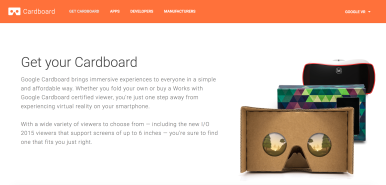Hi world! This week in class, we learned about virtual reality and augmented reality as well as mixed reality. All really interesting, merely based off their names itself. I’m all in for all types of reality – parallel and alternate realities as well! Furthermore, I took Marketing earlier in Poly so I get extra excited when I read about cool and out of the box marketing campaigns. When I was doing my research for this blog entry, I stumbled upon a plethora of marketing efforts from various organisations jumping on the bandwagon to exploit the features of this burgeoning technology.
But who can blame these companies? The engaging aspects of VR and AR are game-changing and you’ll be left out to bite your competitors’ dust if you don’t adopt them. However, instead of focusing on the commercial marketing campaigns, I would like to share and elaborate on those done for good causes. These campaigns aim to generate awareness of significant issues such as war refugees, saving mother earth and aid in the healthcare and the medical industries.
Before we move on to talk about those campaigns, I would like to first do a quick summary of the definitions and distinctions of the different reality-technology. Also, I had this burning question within me during class so I did a bit of research on how VR and AR works. When Mr Abel was showing us the videos featuring augmented reality technology, I could not focus on the content. All I had in mind was “HOW?” “HOW DID THEY DO THAT?”



(All the apt gpoys, I can’t choose one)
So if you’re the curious cat like me, feel free to check out the links at the bottom of this post a more elaborate explanation. Here’s my attempt to explain without the technical jargons.
What is virtual reality and how it works:

VR puts you in an artificial reality setting, you are then detached from the real world. You can explore the simulated reality with a headset (head mounted display) and other accompanying equipment such as data gloves.
In order to indulge in the immersive experience by VR, you will be required to put on a headset. Videos are then sent to the headsets or typically played on the smartphone attached to the headset. Situated between your eyes and the screen is a pair of lenses. These lenses play a pivotal role in creating the 3D effect. They transform the 2D images into 3D by angling the visuals in certain angles that foster the “pop-out effects”.
What is augmented reality and how it works:

Unlike VR, AR features computer generated visuals and superimposes them onto the real world. The user is NOT completed immersed into a simulated like VR. Instead, they experience a blend of both actual and digital realities. In fact, both realities interact with each other!
AR is closer than VR to the real world. Unlike VR, AR does not require a headset but it uses a camera and or smartphone and sometimes a projector and a mirror. It first captures your surrounding with the camera or a webcam. The device only contains a software which processes the footage or image to be displayed and digitally projects the image onto the object.
Again, I don’t think I did a good job explaining how it works but kindly refer to the links below for more information!
Now let’s move on to talk more about the campaigns which I found captivating and inspiring. The marriage between technology and making the world a better place reminds us that we have agency over how we can use these up-and-coming electronic tools.
The Displaced – by The New York Times Magazine
The New York Times clinched several prestigious awards such as the “The Most Next Award” at the Association of Independent Commercial Producers’ annual AICP Next Awards as well as the Grand Prix over at the Cannes Lions festival last year in 2016. The renowned newspaper/magazine organisation produced a VR film to generate awareness for the uprooted war refugees, specifically the 30 million children. The video provided an immersive and absolutely riveting experience for the users into the lives of three refugee children. The VR technology allowed for immense engagement to tug at the heart strings of the viewers as it made them feel like they were physically there with the children, seeing everything unfold.

“The magazine’s editor, Jake Silverstein, said, “The power of VR is that it gives the viewer a unique sense of empathic connection to people and events.” It has huge potential, he said, to help bring viewers news and stories from the most inaccessible places.” – A quote from the NY Times article titled “The Times Partners With Google on Virtual Reality Project“.
Google, everybody’s best friend partnered with NY Times to publish the articles online quickly as well as to launch the Google cardboard project, to provide the viewers with cheap options to purchase and create their very own cardboard viewers to watch the VR video.

So, go get yourself or check out YouTube to DIY your own VR headsets and watch the video below:
Next up, another successful campaign in Manitoba, Canada. In 2016, A non-profit organisation, Canadian Beverage Container Recycling Association (CBCRA) created and rolled out a mobile application called “Recycling Starts Here” to entice the younger audience to engage in recycling habits by making it more fun and enjoyable. These efforts are aligned with the Manitoban’s government goals of recycling 75% of bottles and cans in Canada.
Way to go Canada!

Upon downloading the application on their mobile phones (available on both Android and iOS), the participants were tasked to look for four special “Recycle Everywhere bins” situated in Manitoba’s capital city, Winnipeg. Apart from interacting with the special bins which entitled them to immediate prizes, tagging other unmarked recycling bins also allowed the users to snag other instant prizes.

Lastly, here’s a few cool medical applications for VR and AR in the medical field:
Exposure therapy – this typically involves exposing the patient to their phobias (e.g fear of flying – Acrophobia or bugs – Entomophobia). With AR and VR, a safe simulated environment can be created to bring the patients closer to facing and eventually overcoming their fears gradually step by step. In fact, the treatment is gaining so much recognition for its efficacy that they named it virtual reality therapy.

Post Traumatic Stress Disorder (PTSD) – like its name suggests, the patient has suffered due to a distressing event in his or her life such as war soldiers. Similarly, they create a safe environment for the soldiers or patients to relive and deal with their traumatic experiences.

Phantom limb syndrome – For patients who have lost their limbs and still feel sensations (such as excruciating pain and itch) from the missing limb even though it is not there physically. The typical issue is a clenched fist that causes considerable discomfort to the patient. With VR, sensors pick up pain signals in the brain when the patient senses the discomfort. Then, the VR game tasks the patients to use their virtually created limb to complete certain missions. This allows the patients to have control over their limb and thus overcome the sensations of the missing limb.

Social training for young children with autism – VR is used to create simulated social environments (such as interviews and dates) using virtual agents/avatars/bots. This enables the children to hone in on their social skills and pick up on social cues.

AR assisted surgery – It is currently mostly used as a medical training tool which superimposes the surgeon’s view during an operation to create an immersive and realistic experience for the medical students.

Virtual, augmented and mixed reality alike, they are all very impressive and fascinating technologies to look out for in the near future. Let’s look forward to the future as per depicted in:
sci-fi films (hologram messages from a robot)

and magic (harry potter newspapers)!

References:
https://www.vrs.org.uk/augmented-reality/how-it-works.html
https://www.wareable.com/vr/how-does-vr-work-explained
http://www.businessinsider.com/11-amazing-augmented-reality-ads-2012-1?IR=T&r=US&IR=T
http://www.augment.com/blog/10-use-cases-of-augmented-reality-marketing/
http://www.marxentlabs.com/how-5-top-brands-use-virtual-reality-marketing/
http://www.canadiangrocer.com/top-stories/new-augmented-reality-app-brings-recycling-to-life-67733
http://associationsnow.com/2016/08/associations-augmented-reality-app-tries-make-recycling-exciting/
Virtual Reality Therapy: Treating The Global Mental Health Crisis
https://appreal-vr.com/blog/augmented-reality-for-healthcare/

I really love your GIF for the perverted guy using AR. Haha.
On a serious note, I didn’t know that AR have so many applications such as health, psychology and the obvious gaming industry. Thanks for sharing and explaining, I think you did a great job!
LikeLiked by 1 person